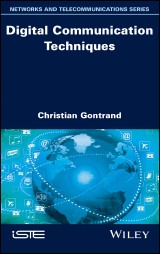Details
Digital Communication Techniques
1. Aufl.
|
139,99 € |
|
| Verlag: | Wiley |
| Format: | EPUB |
| Veröffentl.: | 19.02.2020 |
| ISBN/EAN: | 9781119705246 |
| Sprache: | englisch |
| Anzahl Seiten: | 342 |
DRM-geschütztes eBook, Sie benötigen z.B. Adobe Digital Editions und eine Adobe ID zum Lesen.
Beschreibungen
<P>There have been considerable developments in information and communication technology. This has led to an increase in the number of applications available, as well as an increase in their variability. As such, it has become important to understand and master problems related to establishing radio links, the layout and flow of source data, the power available from antennas, the selectivity and sensitivity of receivers, etc. <P>This book discusses digital modulations, their extensions and environment, as well as a few basic mathematical tools. <P>An understanding of degree level mathematics or its equivalent is a prerequisite to reading this book. Digital Communication Techniques is aimed at licensed professionals, engineers, Master�s students and researchers whose field is in related areas such as hardware, phase-locked loops, voltage-controlled oscillators or phase noise.
<p>Acknowledgements ix</p> <p>Preface xi</p> <p>Introduction xiii</p> <p>History Pages xxxv</p> <p>List of Acronyms xxxix</p> <p><b>Chapter 1. Modulation </b><b>1</b></p> <p>1.1. Modulation? 1</p> <p>1.1.1. Main reasons for modulation 1</p> <p>1.1.2. Main modulation schemas 1</p> <p>1.1.3. Criteria for modulation via electronics 2</p> <p>1.1.4. Digital modulation: why do it? 2</p> <p>1.2. Main technical constraints 2</p> <p>1.3. Transmission of information (analog or digital) 6</p> <p>1.3.1. Characteristics of the signal that can be modified 7</p> <p>1.3.2. Amplitude and phase representation in the complex plane 7</p> <p>1.4. Probabilities of error 10</p> <p>1.4.1. Bit error ratio versus signal to noise ratio 11</p> <p>1.4.2. Demodulator: intended recipient decoder 12</p> <p>1.5. Vocabulary of digital modulation 14</p> <p>1.6. Principles of digital modulations 17</p> <p>1.6.1. Polar display 19</p> <p>1.6.2. Variations of parameters: amplitude, phase, frequency 19</p> <p>1.6.3. Representation in a complex plane 20</p> <p>1.6.4. Eye diagram 21</p> <p>1.7. Multiplexing 23</p> <p>1.7.1. Frequency multiplexing 24</p> <p>1.7.2. Multiplexing – time 25</p> <p>1.7.3. Multiplexing – code 26</p> <p>1.7.4. Geographical (spatial) multiplexing 26</p> <p>1.8. Main formats for digital modulations 26</p> <p>1.8.1. Phase-shift keying 28</p> <p>1.8.2. BPSK 31</p> <p>1.8.3. The QPSK 37</p> <p>1.9. Error vector module and phase noise 63</p> <p>1.9.1. Plot QPSK reference constellation 69</p> <p>1.9.2. Effects of phase noise on 16-QAM 75</p> <p>1.9.3. Phase noise: effects of the signal spectrum 76</p> <p>1.9.4. Algorithms 78</p> <p>1.9.5. Spectrum analyzer 79</p> <p>1.9.6. Measures of the error vector module of a signal modulated by a noisy 16-QAM 81</p> <p>1.10. Gaussian noise (AWGN) 81</p> <p>1.10.1. AWGN channel 83</p> <p>1.10.2. Ratio between EsNo and SNR 84</p> <p>1.10.3. Behavior for real and complex input signals 85</p> <p>1.11. QAM modulation in an AWGN channel 85</p> <p>1.11.1. QAM demodulation 89</p> <p>1.11.2. Detecting phase error 90</p> <p>1.12. Frequency-shift keying 93</p> <p>1.12.1. Binary FSK 94</p> <p>1.13. Minimum-shift keying 95</p> <p>1.13.1. Bit error ratio (BER)/Gaussian channel 97</p> <p>1.13.2. Typical analytical expressions used in “berawgn” 98</p> <p>1.14. Amplitude-shift keying 99</p> <p>1.14.1. On–off keying 99</p> <p>1.14.2. Modulation at “M states” 101</p> <p>1.15. Quadrature amplitude modulation 104</p> <p>1.15.1. Limits on theoretical spectral efficiency 105</p> <p>1.15.2. I/Q imbalance 106</p> <p>1.15.3. QAM-M constellations 109</p> <p>1.16. Digital communications transmitters 117</p> <p>1.16.1. A digital communications receiver 118</p> <p>1.16.2. Measures of power 120</p> <p>1.16.3. Power of the adjacent channel 121</p> <p>1.16.4. Frequency measures 121</p> <p>1.16.5. Synchronization measures 123</p> <p>1.17. Applications 129</p> <p>1.17.1. Domains 129</p> <p>1.17.2. Digressions or precisions, around modulations 131</p> <p><b>Chapter 2. Some Developments in Modulation Techniques </b><b>137</b></p> <p>2.1. Orthogonal frequency division multiplexing 137</p> <p>2.1.1. Introduction 137</p> <p>2.1.2. Multicarrier modulations 138</p> <p>2.1.3. General principles 143</p> <p>2.1.4. How to choose N? 145</p> <p>2.1.5. Practical aspects 145</p> <p>2.1.6. COFDM 147</p> <p>2.1.7. Equalization and decoding 149</p> <p>2.1.8. The multiuser context 150</p> <p>2.1.9. Code division multiple access 150</p> <p>2.1.10. Schematic ordinogram 152</p> <p>2.1.11. Data in OFDM 155</p> <p>2.1.12. OFDM: advantages and disadvantages 156</p> <p>2.1.13. Intermediate conclusion 157</p> <p>2.1.14. QPSK and OFDM with MATLAB system objects 159</p> <p>2.1.15. FDM versus OFDM: difference between FDM and OFDM 162</p> <p>2.2. A note on orthogonality 170</p> <p>2.3. Global System for Mobile Communications 174</p> <p>2.3.1. Introduction 174</p> <p>2.3.2. Forming a GSM 175</p> <p>2.4. MIMO 178</p> <p>2.4.1. Introduction 178</p> <p>2.4.2. Principles 178</p> <p>2.4.3. Uses 182</p> <p><b>Chapter 3. Signal Processing: Sampling </b><b>183</b></p> <p>3.1. Z-transforms 183</p> <p>3.1.1. Transforms 183</p> <p>3.1.2. Inverse z-transform 184</p> <p>3.2. Basics of signal processing 187</p> <p>3.3. Real discretezation processing 190</p> <p>3.3.1. Real discretization comb 190</p> <p>3.3.2. Real sampled signal 191</p> <p>3.3.3. Blocked, sampled signal 191</p> <p>3.3.4. Model of real sampled signals 192</p> <p>3.3.5. Uniform quantifying 192</p> <p>3.3.6. Signal quantification step: rounding 192</p> <p>3.3.7. Signal quantification step: troncature 193</p> <p>3.3.8. Quantification solution 193</p> <p>3.3.9. Additive white Gaussian noise (AWGN): a simple but effective model 193</p> <p>3.3.10. Quantification error and quantification noise 193</p> <p>3.3.11. In practice, sample and hold and CAN 194</p> <p>3.3.12. Spectra of periodic signals 195</p> <p>3.3.13. Non-periodic signal spectrums 195</p> <p>3.3.14. PSD versus delay 197</p> <p>3.3.15. FT of a product: the Plancherel theorem 197</p> <p>3.3.16. Periodic signal before sampling 198</p> <p>3.3.17. Spectrum of sampled signals 198</p> <p>3.3.18. Conditions for sampling frequency 199</p> <p>3.4. Coding techniques (summary) 200</p> <p><b>Chapter 4. A Little on Associated Hardware </b><b>203</b></p> <p>4.1. Voltage-controlled oscillator 203</p> <p>4.2. Impulse sensitivity function 209</p> <p>4.3. Phase noise 210</p> <p>4.3.1. At passage to zero 212</p> <p>4.3.2. At the peaks 212</p> <p>4.4. Phase-locked loop 219</p> <p>4.4.1. Study of a fundamental tool: the PLL 219</p> <p>4.4.2. Schematic structure of the PLL 220</p> <p>4.4.3. Operation of the loop: acquisition and locking 222</p> <p>4.4.4. Charge pump 229</p> <p>Conclusion 231</p> <p>Appendices 233</p> <p>Appendix 1 235</p> <p>Appendix 2 243</p> <p>Appendix 3 263</p> <p>References 291</p> <p>Index 293</p>
<p><b>Christian Gontrand</b> is Professor at the INL/INSA Lyon Institute in France and at INSA Fes, Euro-Mediterranean University, in Morocco, as well as responsible for 3D integration there. He is also the former head of the "Smart System Integration" team at INSA Lyon’s AMPERE lab. His research interests include microwave devices, heterogenic 2D or 3D circuits and systems, and telecom firmware.</p>



















